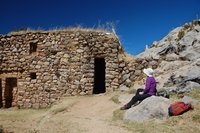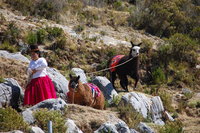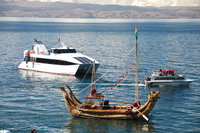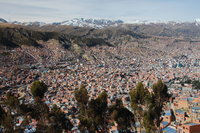
We flew into the highest international airport at La Paz without incident - which is nice. La Paz city is situated in a bowl and the airport is on the rim. As we hurtled down the hill (more like over the cliff), our taxi driver assured us that the smog would clear later in the day and we would be able to see the city then. In actual fact, other than the dramatic setting of the city, there is very little to see here. We took a bus tour around the city and they have something called Moon Valley which is really just a small pile of water eroded rocks in weird shapes. The most impressive thing about Moon Valley was that they haven't built on it!
As befits a teeming South American metropolis, the place is bustling and hectic. A constant cacophony of car horns and hollering bus conductors assaults the ears whilst various probably best left unmentioned smells assail the nostrils. The inhabitants here don't obey any driving laws so the city employs people to dress up as zebras and dance around in the road to try and control the traffic. Rather surprisingly, it does seem to benefit the poor pedestrian.
There are lots of markets catering to the gringo trade and locals alike with the stereotypical colourful garments being in abundance. On that note, we seem to be the only westerners here not decked out in llama pullovers and odd hats with dangly bits on them. There is also the so called witches market where you can buy all sorts of potions, unguents and idols not to mention llama foetuses. Handy really.
On the outer rim of the crater that is La Paz is what is known as El Alto which is La Paz's alter ego. People are considerably poorer up here and they do not seem to benefit from the chaos down below. They simply seem to generate their own chaos. It took us nearly an hour to drive through El Alto on the way to Bolivia's second important pre-Inca site Tiahuanaku (El Fuerte was the first). Tiahuanaku sits on a desolate plane high above La Paz and is largely ruined. Only recently has a preservation effort been undertaken but, in common with much here, the Bolivians do not seem to really value the archaeological aspect of their heritage. As far as Inca ruins go, this is not very impressive. Having now seen both of the most important sites in the country, we would have to say this is not the place to come if you are a ruin hunter.
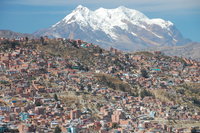
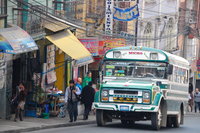
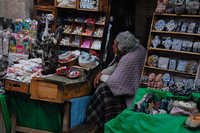
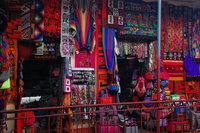
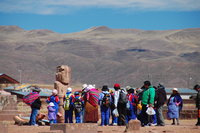
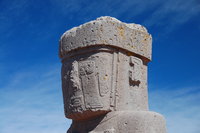
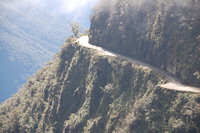
Whilst in La Paz, we thought it would be amiss not to take a cycle ride down the world's most dangerous road also known as THE DEATH ROAD!!! Top Gear made a meal out of it so we thought we would take a look! The road runs from La Cumbre pass at 4800m down (down and down) to the town of Yolosa at 1200m above sea level. That's a drop of 3600m in 63km. That would be quite a ride, but this road was christened the most dangerous in the world due to the estimated 200 to 300 deaths per year that occur on it; generally due to people driving over the edge. Apparently, passing oncoming vehicles was particularly hazardous since the road is, in places, only 3m wide and being carved out of nearly vertical cliff face, the drop on one side of the road could be described as impressive! In places, waterfalls cascade onto the road which spices things up a bit for those getting bored. Of course, the road is gravel and loose rocks, tarmac would just be too easy!
We hooked up with a company appropriately called Gravity who supplied us with top quality mountain bikes, all the gear you could want and some great guides. We were driven up to the top of the La Cumbre pass where we kitted up and set off.
The first 20km do not contain any massive precipices and are, in fact, tarmac. This is part of the new road that was built to relieve the traffic on the death road to try and reduce accidents which it has done. On this part, all we had to do was safely overtake slow moving lorries in low gear. That would be fine except for the uncanny Bolivian ability to round blind corners three abreast in some crazy South American overtaking manoeuvre. Still, we were going so fast as we overtook that the statistics were on our side.
Having safely navigated the tarmac with only one guy falling off, we hit the dirt and the real Death Road. Here, obviously, we went a little slower and there were frequent stops to admire the scenery and, we think, just to slow everyone down a bit. We had a nasty bit to navigate by a large landslide and one guy managed to come off his bike and chip a bone in his elbow so we were one down by the end.
It was rather hard to admire the scenery whilst trying to make sure you stayed on it, but we had been promised that the bus would bring us back up and stop frequently for photos (see, we didn't have to cycle back up). However, we ended up delayed at the bottom in Yolosa and didn't end up leaving until 5:30. Rather amusingly, this meant the bus would be going back up the Death Road...IN THE DARK!!! Steve had chatted with the driver during the day and discovered that he had been driving the road for 20 years and eight of them for this company. So we were not too freaked out as the sun set, even when the driver didn't bother to turn the lights on. He seemed to feel it was easier to navigate the road by what natural light there was - who are we to argue? Of course, we didn't get the photos, but we did survive the Death Road... twice.
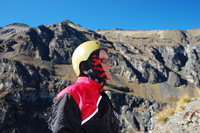
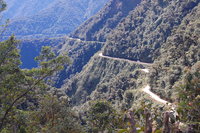
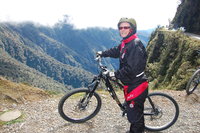
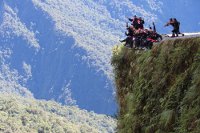
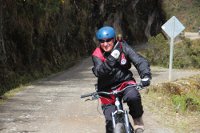
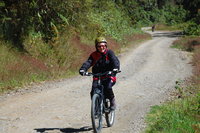
Our time in Bolivia was drawing to a close and we were setting our sights on Peru. Our final destination was the town of Copacabana on the shores of Lake Titikaka. Apparently, some quite a number of people mistake this place for the one in Brazil (and in that song). They would be disappointed. However, since Bolivia does not have a coastline since Chile stole it, they have to make do with this place. So, they come from La Paz in droves to eat ice cream and hire big plastic swans you can pedal around the lake in. You could only pedal around part of the lake as it is the largest navigable lake in the world (what ever that means). Bolivia keeps its navy here! The tourists also bring their cars here to be blessed by the local monks. They hope for a safe and reliable car. They then proceed to get quite drunk before driving back to La Paz. Let's hope those blessings worked!
Of course, Lake Titikaka is famous for its peoples that live on the islands constructed entirely out of reeds and row around in reed boats catching trout. Unfortunately, that occurs over the border on the Peruvian part of the lake. So, we passed a couple of days here being sick from dodgy food. We did also visit the Isla del Sol which is the birthplace of the Inca civilisation. Again, being Bolivia, hardly anything to see of the Incas now, but a very nice day out walking the island. Those of you who know about boats will be amused to know that the 40' craft carried about 45 people and was powered by a single 75HP Yamaha outboard! For those not so familiar with boats, it was a slow ride!
So, we left Copacabana mostly recovered and a little sorry to see the end of our time in Bolivia. Next time, we'll have something to say about Peru. As ever, thanks for sticking with us and best wishes to everyone.
